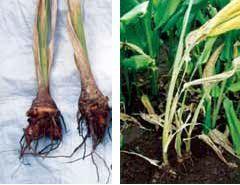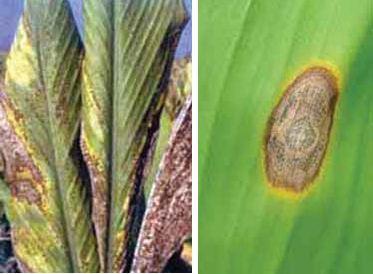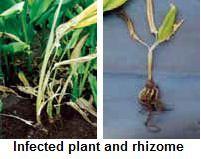Turmeric: Diseases and Symptoms
Turmeric: Diseases and Symptoms
Rhizome rot
The disease is soil-borne and rhizomes borne and occurs with the onset of monsoon. This disease mostly occurs during the months of June to September.
Disease symptoms The infection starts at the collar region of the pseudostem and progresses upwards as well as downwards.
The infection starts at the collar region of the pseudostem and progresses upwards as well as downwards.- The collar region of the affected pseudostem becomes water soaked and the rotting spreads to the rhizome resulting in soft rot.
- At a later stage root infection is also noticed.
- Foliar symptoms appear as light yellowing of the tips of lower leaves which gradually spreads to the leaf blades.
- In early stages of the disease, the middle portion of the leaves remain green while the margins become yellow.
- Later, the yellowing spreads to all leaves of the plant from the lower region upwards and is followed by drooping, withering and drying of pseudostems.
- The disease is soil-borne. The fungus multiplies with buildup of soil moisture with the onset of south west monsoon.
- The fungus can survive in two ways: (a) in diseased rhizomes kept for sowing and (b) through resting structures like chlamydospores and oospores that reach the soil from infected rhizomes.
- Favourable conditions
- Younger sprouts are the most susceptible to the pathogen. Nematode infestation aggravates rhizome rot disease.
- Temperature above 30° C and high soil moisture are the important predisposing factors favouring the disease.
- Water logging in the field due to poor drainage increases the intensity of the disease.
Leaf spot
Disease is soil-borne noticed on the leaves from July to October.
Disease symptoms- Symptom appears as brown spots of various sizes on the upper surface of the young leaves.
- The spots are irregular in shape and white or grey in the centre.
- Later, spots may coalesce and form an irregular patch covering almost the whole leaf.
- The centre of spots contains fruit head shaped fruiting structures.
- Disease is soil borne and survives in plant debris.
- The disease spreads through rain splashes during intermittent showers. The incidence of the disease is severe in turmeric grown under exposed conditions
- High soil moisture, temperature 25° C and leaf wetness.
Leaf blotch
Disease symptoms Disease symptom appears as small, oval, rectangular or irregular brown spots on either side of the leaves which soon become dirty yellow or dark brown.
Disease symptom appears as small, oval, rectangular or irregular brown spots on either side of the leaves which soon become dirty yellow or dark brown.- The leaves also turn yellow.
- In severe cases the plants present a scorched appearance and the rhizome yield is reduced.
- Soil and seed borne and survive in soil on infected plant debris.
- High soil moisture, temperature 25O C and leaf wetness
Dry rot
Disease symptoms The disease causes root rot and rhizome rot resulting in typical dry rot of rhizomes from October onwards.
The disease causes root rot and rhizome rot resulting in typical dry rot of rhizomes from October onwards.- The affected rhizomes appear soft and shrunken to start with, later dry up and become hard.
- Foliar yellowing and drying up of foliage which are the normal symptoms of maturity of the crop during October - November would be indistinguishable from the symptoms of the disease affected clumps.
- When infected rhizomes are cut open, the infected zones typically appear as dull brown and dark.
- The pathogen is facultative parasites and lives as a saprophyte on the organic matter in the soil for several years.
- It spreads from vulnerable plants
- The disease is favoured by 35° C soil temperature, 15-20 per cent soil moisture and alluvial or sandy soils.
Bacterial wilt
Disease symptoms- Rapid wilting and death of the entire plant without any yellowing or spotting of leaves are the characteristic symptom.
- All branches wilt at about the same time.
- When the stem of a wilted plant is cut across, the pith has a darkened, water-soaked appearance.
- Greyish slimy ooze comes out on pressing the stem.
- In later stages of the disease, decay of the pith may cause extensive hollowing of the stem.
- The bacterium is especially destructive in moist soils at temperatures above 24° C.
- High soil temperature and moisture are favourable for disease.
IPM for Turmeric
To know the IPM practices for Turmeric, click here.
Source: NIPHM and Directorate of Plant Protection, Quarantine & Storage
Last Modified : 1/6/2020
© C–DAC.All content appearing on the vikaspedia portal is through collaborative effort of vikaspedia and its partners.We encourage you to use and share the content in a respectful and fair manner. Please leave all source links intact and adhere to applicable copyright and intellectual property guidelines and laws.
RELATED ITEMS
Custard Apple Diseases
This topic covers the information related to disea...
Ber Diseases
This topic covers information about Ber Diseases.
Fig Diseases
This topic covers information about Fig Diseases.
Fennel: Diseases and Symptoms
This topic covers the Information related to Disea...
